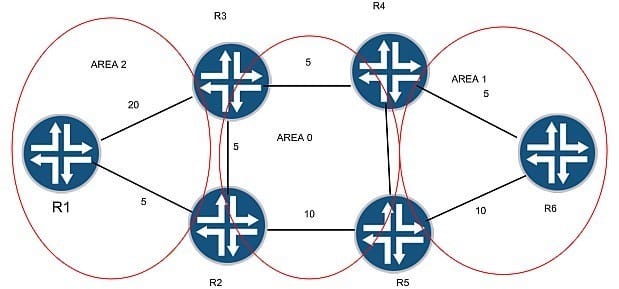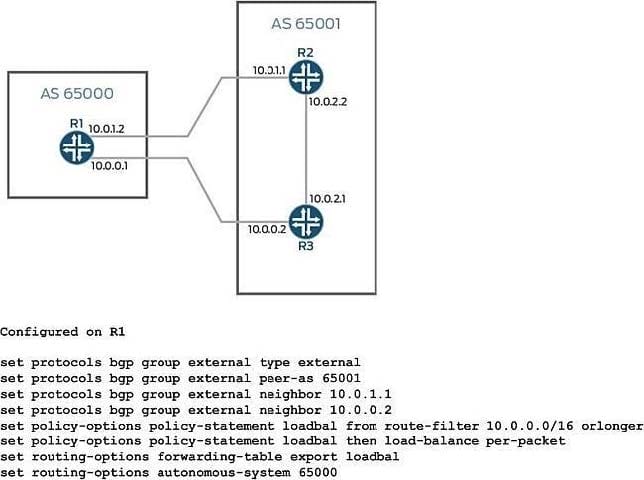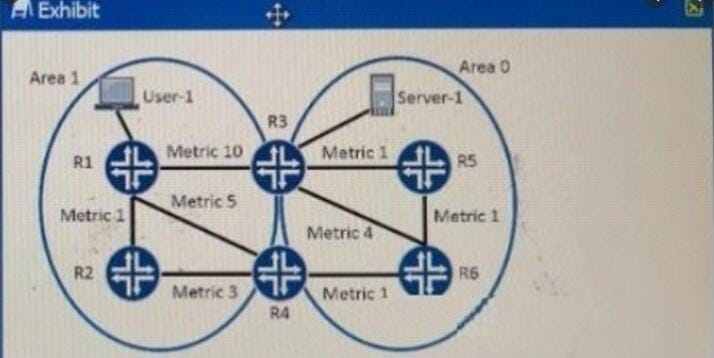JN0-643 Online Practice Questions and Answers
Questions 4
-- Exhibit -user@router> show ospf route Topology default Route Table: Prefix Path Route NH Metric NextHop Nexthop Type Type Type Interface Address/LSP 192.168.1.0/24 Intra Network IP 10 ge-0/0/1.0 -- Exhibit -
Click the Exhibit button.
Which two configurations result in the output shown in the exhibit? (Choose two.)
A. [edit protocols ospf] user@router# show reference-bandwidth 10g; area 0.0.0.0 { interface ge-0/0/1.0; }
B. [edit protocols ospf] user@router# show reference-bandwidth 1g; area 0.0.0.0 { interface ge-0/0/1.0; }
C. [edit protocols ospf] user@router# show reference-bandwidth 1m; area 0.0.0.0 { interface ge-0/0/1.0 { metric 10; } }
D. [edit protocols ospf] user@router# show reference-bandwidth 100m; area 0.0.0.0 { interface ge-0/0/1.0; }
Questions 5
-- Exhibit

-- Exhibit -Click the Exhibit button.
Referring to the exhibit, R2 is sending a route to R1 with a community value.
Which statement is correct?
A. Routes will be accepted without change in the attributes.
B. All routes will be rejected.
C. Routes will be accepted with the community value removed.
D. Routes will be rejected with the community value removed.
Questions 6
-- Exhibit

-- Exhibit -Click the Exhibit button.
R1 is connected to both R2 and R3 and you want to load-balance outbound traffic. You have provided the configuration shown in the exhibit; however, after checking the links you notice that the traffic is not load- balancing.
Which configuration must be added?
A. set protocols bgp group external multihop
B. set protocols bgp group external multipath
C. set protocols bgp group external advertise-external
D. set policy-options policy-statement loadbal then accept
Questions 7
Two PCs are attached to a hub, which is attached to port ge-0/0/0 on your EX Series switch. You must separate the incoming traffic from the PCs into two VLANs.
What should you use to accomplish this task?
A. dynamic VLAN registration with MVRP
B. private VLAN
C. filter-based VLAN
D. guest VLAN
Questions 8
-- Exhibit -{master:0}[edit]
user@switch# show vlans
v200 {
vlan-id 200;
interface {
ge-0/0/7.0;
ge-0/0/8.0;
}
dot1q-tunneling {
customer-vlans [ 11 12 ];
layer2-protocol-tunneling {
all {
drop-threshold 800;
shutdown-threshold 700;
}
}
}
}
-- Exhibit -
Click the Exhibit button.
Referring to the exhibit, you are attempting to configure L2PT for VLAN v200 but the configuration will not commit.
Which three configuration statements would resolve the problem? (Choose three.)
A. set vlans v200 dot1q-tunneling layer2-protocol-tunneling all drop-threshold 600
B. set vlans v200 dot1q-tunneling layer2-protocol-tunneling all shutdown-threshold 600
C. set vlans v200 dot1q-tunneling layer2-protocol-tunneling all shutdown-threshold 900
D. set vlans v200 dot1q-tunneling layer2-protocol-tunneling all drop-threshold 700
E. set vlans v200 dot1q-tunneling layer2-protocol-tunneling all drop-threshold 900
Questions 9
-- Exhibit -{master:0}[edit protocols dot1x]
user@switch# show
authenticator {
authentication-profile-name my-profile;
static {
00:21:cc:ba:c7:00/40 {
interface ge-0/0/12.0;
}
}
interface {
ge-0/0/12.0 {
supplicant multiple;
server-fail deny;
}
ge-1/0/14.0 {
reauthentication 120;
server-fail vlan-name local-only;
}
ge-1/0/15.0 {
supplicant multiple;
mac-radius {
restrict;
}
reauthentication 120;
server-fail vlan-name guest;
}
}
}
-- Exhibit -
Click the Exhibit button.
You just added a device on port ge-0/0/12 with the MAC address 00:21:cc:ba:c7:59. All access ports on this device are members of VLAN v20. The RADIUS server is currently not reachable.
Referring to the configuration shown in the exhibit, what happens to traffic sent from this device?
A. The traffic is denied.
B. The traffic is accepted and uses the guest VLAN.
C. The traffic is accepted and uses the local-only VLAN.
D. The traffic is accepted and uses the v20 VLAN.
Questions 10
-- Exhibit

-- Exhibit -
Click the Exhibit button.
In the exhibit, the provider bridges are using Q-in-Q tunneling to tunnel VLAN 100 traffic over VLAN 200. What is the correct VLAN configuration for Q-in-Q tunneling on Provider Bridge A?
A. interfaces { ge-0/0/0 { unit 0 { family ethernet-switching { port-mode access; } } } ge-0/0/10 { unit 0 { family ethernet-switching { port-mode trunk; vlan { members test; } } } } } vlans { test { vlan-id 200; interface { ge-0/0/0.0; } dot1q-tunneling { customer-vlans 100; } }
}
B. interfaces { ge-0/0/0 { unit 0 { family ethernet-switching {
port-mode trunk;
vlan {
members test;
}
}
}
}
ge-0/0/10 {
unit 0 {
family ethernet-switching {
port-mode access;
}
}
}
}
vlans {
test {
vlan-id 200;
interface {
ge-0/0/0.0;
}
dot1q-tunneling {
customer-vlans 100;
}
}
}
C. interfaces { ge-0/0/0 { unit 0 { family ethernet-switching { port-mode trunk; vlan { members test; } } } } ge-0/0/10 { unit 0 { family ethernet-switching { port-mode access; } } } } vlans { test { vlan-id 200; interface { ge-0/0/10.0; } dot1q-tunneling { customer-vlans 100; } } }
D. interfaces { ge-0/0/0 { unit 0 { family ethernet-switching { port-mode access; } } } ge-0/0/10 { unit 0 { family ethernet-switching { port-mode trunk; vlan { members test; } } } } } vlans { test { vlan-id 100; interface { ge-0/0/0.0; } dot1q-tunneling { customer-vlans 200; } } }
Questions 11
Referring to the exhibit, R2 is exporting the route for server1 as a Type 2 external route and R6 is exporting the route for server 1 as a type 1 external route in OSPF. Which path is taken to reach server-1 from user1?

A. R1>R3>R6
B. R1>R2
C. R1>R4>R6
D. R1>R2>R4>R6
Questions 12
A packet enters the router and is subject to ingress's processing. In which order is the packet processed?
A. Policer >BA classifier>multifield classifier>forwarding policy
B. multifield classifier>BA classifier>policer>forwarding policy
C. BA classifier>multifieldclaasssifier>policer>forwarding policy
D. forwarding policy> BA classifier>multifield classifier>policer
Questions 13
You are receiving the same prefix from multiple EGBP peers in different autonomous systems. Which two configurations enable your systemto load balance across all received instances?
A. multilpath multiple-as
B. policy-statement LB{ Then{ Load-balance per-flow; } }
C. policy-statement LB{ Then{ Load-balance per-packet; } }
D. Multihop
